Reno, Nevada Blood Testing Facilities
 Represents a LabCorp blood testing facility
Represents a LabCorp blood testing facility Represents a Quest Diagnostics blood testing facility
Represents a Quest Diagnostics blood testing facility
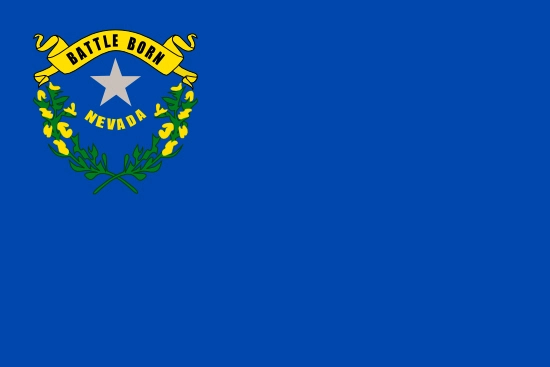
Nearby Labcorp Blood Testing facilities:
- Labcorp Center Distance: 0 m, 890 Mill St Ste 105, Reno, Washoe County, NV, 89502
- Labcorp Center Distance: 2 m, 1901 Silverada Blvd Ste 14, Reno, Washoe County, NV, 89512
- Labcorp Center Distance: 3 m, 601 Sierra Rose Dr 103, Reno, Washoe County, NV, 89511
- Labcorp Center Distance: 4 m, 7111 S Virginia St Ste 19A, Reno, Washoe County, NV, 89511
- Labcorp Center Distance: 5 m, 1339 Baring Blvd, Sparks, Washoe County, NV, 89434
- Labcorp Center Distance: 7 m, 15 Mccabe Dr Ste 103, Reno, Washoe County, NV, 89511
- Labcorp Center Distance: 20 m, 926 Incline Way Ste 105, Incline Village, Washoe County, NV, 89451
- Labcorp Center Distance: 24 m, 604 W Washington St Ste D, Carson City, Other, NV, 89701
- Labcorp Center Distance: 38 m, 1760 Us Hwy 395 Ste L, Minden, Douglas County, NV, 89423
- Labcorp Center Distance: 69 m, 104 Catherine Lane, Grass Valley, Nevada County, CA, 95945
- Labcorp Center Distance: 79 m, 11930 Heritage Oak Pl Ste 7, Auburn, Placer County, CA, 95603
- Labcorp Center Distance: 90 m, 89 Lincoln Blvd., Lincoln, Placer County, CA, 95648
- Labcorp Center Distance: 92 m, 1600 Creekside Dr Ste 3500, Folsom, Sacramento County, CA, 95630
- Labcorp Center Distance: 93 m, 1008 Riley St Ste 4, Folsom, Sacramento County, CA, 95630
- Labcorp Center Distance: 94 m, 1730 Santa Clara Dr, Roseville, Placer County, CA, 95661
- Labcorp Center Distance: 99 m, 6620 Coyle Ave Ste 109, Carmichael, Sacramento County, CA, 95608
Nearby Quest Blood Testing facilities:
- Quest Center Distance: 0 m, 343 Elm St, Reno, Washoe County, NV, 89503-4540
- Quest Center Distance: 3 m, 6502 S Mccarran Blvd, Reno, Washoe County, NV, 89509-6139
- Quest Center Distance: 5 m, 780 Vista Blvd, Sparks, Washoe County, NV, 89434-6675
- Quest Center Distance: 23 m, 2874 N Carson St, Carson City, Other, NV, 89706-1681
- Quest Center Distance: 79 m, 3133 Professional Drive, Auburn, Placer County, CA, 95603-2463
- Quest Center Distance: 92 m, 1600 Creekside Drive, Folsom, Sacramento County, CA, 95630-3445
- Quest Center Distance: 93 m, 670 Oro Dam Blvd E, Oroville, Butte County, CA, 95965-5746
- Quest Center Distance: 96 m, 6573 Clark Road, Paradise, Butte County, CA, 95969-3503
Nevada Hormone Replacement Therapy Services
Nevada is a sunny and bright land of opportunity. Don't let Hormone Deficiency and Imbalance get in the way of your ability to make the most of your life. The Conscious Evolution Institute is Nevada's premier provider of HGH and Testosterone Replacement Services. We don't just serve Las Vegas and Reno, we serve every corner of Nevada, and we have partnered physicians all throughout the state that can provide the preliminary examination needed to get you approved for therapy.
If you are a man or woman over the age of 30, and you feel that Hormone Imbalance is taking the zest out of life, we can help you get diagnosed and treated. With just a simple blood sample, we can run a battery of tests to provide our HRT Doctors with all of the information that they need to make a responsible and accurate diagnosis. Once you're approved, we can send your Physician-Prescribed Hormone Replacement Therapy straight to your home.
Nevada Low-T Therapy
If you are a man and you are experiencing issues that prevent you from enjoying fulfilling sexual activity, you are a prime candidate for Bio-Identical Testosterone HRT. Andropause is a real medical condition that affects middle-aged men, and it significantly hinders both sexual desire and sexual ability.
Now, Erectile Dysfunction medications are a viable treatment option for sexual impotence, but these pills do not restore Testosterone Levels, they simply facilitate erections. Testosterone Deficiency is a multifaceted medical disorder which affects cardiovascular health, negatively impacts body composition, and increases the risk of a number of negative health conditions such as heart attack, diabetes, and stroke.
Luckily, Testosterone Deficiency can be easily treated via a number of different forms of Testosterone Therapy, including Creams, Gels, Sprays, and Injections. Many women can benefit from Testosterone Replacement, and it can be an effective means to mitigate the effects of menopause and restore sexual desire and function.
Nevada Bio-Identical HGH Hormone Replacement Therapy
How much do you really know about Human Growth Hormone? Did you know that it's one of the main tools that your body uses to sustain itself? HGH is a potent hormone which stimulates cellular division and metabolism. When you are young, you produce a lot of HGH, and it causes you to grow.
Once you reach your Final Adult Height, your body produces less of the hormone, enough to optimize your body's function. By the early thirties, however, HGH Production starts to slowly decline, to the detriment of your psychological and physical health.
HGH Deficiency has a number of symptoms that ruin your health. It reduces your fat metabolism and makes it harder to maintain muscle mass. It makes your immune system weaker and it slows down your body's ability to rehabilitate itself. If you are out of energy, and you feel like you're aging more quickly than you should, HGH or Sermorelin Acetate may be the treatment that you've been looking for.
Nevada Weight Loss with HCG
The Conscious Evolution Institute also provides highly effective weight loss plans, including the HCG Diet. If you are overweight and have a history of having trouble with diets, this may be the perfect diet for you. HCG stands for Human Chorionic Gonadotropin, and this Hormone Therapy, when combined with a restrictive diet, has been proven to help patients lose as much as thirty pounds per month.
The key to the diet is that it suppresses your body's hunger signals, which makes dieting easier, while encouraging the body to burn bodyfat, which makes dieting more efficient. Call us to get started!
Major Cities in Nevada
Las Vegas
Las Vegas is the largest city in the state of Nevada, and is one of the premier tourist destinations in the United States. Las Vegas is known for its bright neon lights, immense casinos, and flashy tourist attractions. The city is known as The Entertainment Capital of the World.
The city is also home to a number of museums, including the National Atomic Testing Museum and the Las Vegas Natural History Museum. Other cultural destinations include the Smith Center for the Performing Arts and the Southern Nevada Zoological-Botanical Park.
Henderson
Henderson is the largest suburb of Nevada, and is the second most populous city in the state. Henderson has garnered a number of national accolades. Bloomberg Businessweek considers it one of the best cities in the country to live, and Forbes considers it one of the safest cities in the United States . The city is one of the wealthier cities in the nation, and among the top employers are Sunset Station, M Resort, and Green Valley Ranch.
North Las Vegas
North Las Vegas is the third most populous city in the state of Nevada, and is immediately adjacent to Las Vegas. Although North Las Vegas does cater strongly to tourists like its other half, it boasts a strong economy outside of entertainment as well. The city has a large number of high tech businesses and environmentally friendly companies, and the city is also caters heavily to entrepreneurial investors, start ups, and small businesses. Nellis Air Force Base enhances the economy with its military presence.
Reno
Reno, Nevada is located on the west-central border of the state, and is the fourth largest city in the state. Like Las Vegas, Reno is renowned for its large and various casinos. Reno's nickname is The Biggest Little City in the World. Reno is the original home of one of the largest Casino companies in the world, Caesars Entertainment Corporation. A number of companies are based out of Reno, including Bally Technologies, PC-Doctor, Hamilton, and Braeburn Capital.
Sunrise Manor
Sunrise Manor is the third most populous suburb of Las Vegas, and the fifth largest area of Nevada. Sunrise Manor is a census-designated place, but is officially an unincorporated community. The community is located on the eastern side of Las Vegas, and sits at the base of Frenchman Mountain. The most well-known landmark in the city is the Las Vegas Nevada Mormon Temple.
All About Reno, Nevada Geographic Area
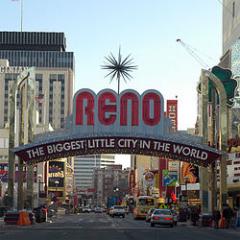
Reno is the county seat of Washoe County, Nevada, United States. The city has a population of 225,221 and is the most populous Nevada city outside of the Las Vegas metropolitan area. Reno sits in a high desert valley at the foot of the Sierra Nevada.
Known as The Biggest Little City in the World, Reno is famous for its casinos, and is the birthplace of the gaming corporation Harrah's Entertainment. The Reno-Sparks metropolitan area is informally called the Truckee Meadows, and consists of about 400,000 residents.
Archaeological finds place the eastern border for the prehistoric Martis people in the Reno area.
As early as the 1850s a few pioneers settled in the Truckee Meadows, a relatively fertile valley through which the Truckee River made its way from Lake Tahoe to Pyramid Lake. In addition to subsistence farming, these early residents could pick up business from travelers along the California Trail, which followed the Truckee westward, before branching off towards Donner Lake, where the formidable obstacle of the Sierra began.
Gold was discovered in the vicinity of Virginia City in 1850 and a modest mining community developed, but the discovery of silver in 1859 at the Comstock Lode led to a mining rush.
To provide the necessary connection between Virginia City and the California Trail, Charles W. Fuller built a log toll bridge across the Truckee River in 1859. A small community that would serve to service travelers soon grew up near the bridge. After two years, Fuller sold the bridge to Myron C. Lake, who continued to develop the community with the addition of a grist mill, kiln, and livery stable to the hotel and eating house. He renamed it Lake's Crossing. In 1864, Washoe County was consolidated with Roop County; Lake's Crossing became the largest town in the county. Lake had earned himself the title "founder of Reno."
By January 1863, the Central Pacific Railroad (CPRR) had begun laying tracks east from Sacramento, California, eventually connecting with the Union Pacific Railroad at Promontory, Utah to form the first transcontinental railroad. Lake deeded land to the CPRR in exchange for its promise to build a depot at Lake's Crossing. Once the railroad station was established, the town of Reno officially came into being on May 9, 1868. CPRR construction superintendent Charles Crocker named the community after Major General Jesse Lee Reno, a Union officer killed in the American Civil War at the Battle of South Mountain.
In 1871, Reno became the county seat of the newly expanded Washoe County, replacing the previous county seat, located in Washoe City. However, political power in Nevada remained with the mining communities, first Virginia City and later Tonopah and Goldfield.
The extension of the Virginia and Truckee Railroad to Reno in 1872 provided a boost to the new city's economy. In the following decades, Reno continued to grow and prosper as a business and agricultural center and became the principal settlement on the transcontinental railroad between Sacramento and Salt Lake City.
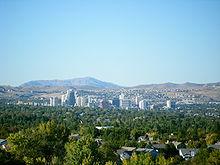
As the mining boom waned early in the 20th century, Nevada's centers of political and business activity shifted to the non-mining communities, especially Reno and Las Vegas, and today the former mining metropolises stand as little more than ghost towns. Despite this, Nevada is still the third-largest gold producer in the world, after South Africa and Australia; the state yielded 6.9 percent of the world's supply in 2005 world gold production.
The "Reno Arch" was erected on Virginia Street in 1926 to promote the upcoming Transcontinental Highways Exposition of 1927, the arch included the words "Nevada's Transcontinental Highways Exposition" and the dates of the exposition. After the exposition, the Reno City Council decided to keep the arch as a permanent downtown gateway, and Mayor E.E. Roberts asked the citizens of Reno to suggest a slogan for the arch. No acceptable slogan was received until a $100 prize was offered, and G.A. Burns of Sacramento was declared the winner on March 14, 1929 with "Reno, The Biggest Little City in the World".
Reno took a leap when the state of Nevada legalized open-gambling in 1931, along with the passage of even more liberal divorce laws than places like Hot Springs, Arkansas offered. No other state offered what Nevada did in the 1930s, and casinos like the Bank Club and Palace were popular.
Within a few years, the Bank Club, owned by George Wingfield, Bill Graham, and Jim McKay, was the state's largest employer and the largest casino in the world. Wingfield owned most of the buildings in town that housed gaming and took a percentage of the profits, along with his rent.
Ernie Pyle once wrote in one of his columns "All the people you saw on the streets in Reno were obviously there to get divorces." In Ayn Rand's novel The Fountainhead, published in 1943, the New-York-based female protagonist tells a friend "I am going to Reno," which is taken as a different way of saying "I am going to divorce my husband." Among others, the Belgian-French writer Georges Simenon, at the time living in the US, came to Reno in 1949 in order to divorce his first wife.
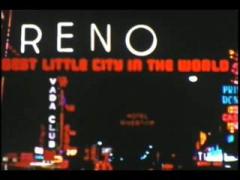
The divorce business eventually died as the other states fell in line by passing their own laws easing the requirements for divorce, but gambling continued as a major Reno industry. While gaming pioneers like "Pappy" and Harold Smith of Harold's Club and Bill Harrah of the soon to dominate Harrah's casino set up shop in the 1930s, the war years of the 1940s cemented Reno as the place to play for two decades. Beginning in the 1950s, the need for economic diversification beyond gaming fueled a movement for more lenient business taxation.
A disaster occurred on the afternoon of February 5, 1957, when an explosion ripped through the heart of downtown. At 1:03 pm, two explosions, caused by natural gas leaking into the maze of pipes and ditches under the city, and an ensuing fire destroyed five buildings in the vicinity of Sierra and First streets along the Truckee River. Forty-nine people were injured in the disaster and two were killed. The first explosion hit under the block of shops on the west side of Sierra Street (now the site of the Century Riverside), the second, across Sierra Street, now the site of the Palladio.
The presence of a main east-west rail line, the emerging interstate highway system, favorable state tax climate, and relatively inexpensive land created good conditions for warehousing and distribution of goods.
Major new construction projects have been completed in the Reno and Sparks areas. A few new luxury communities were recently built in Truckee, CA, approximately 28 miles west of Reno on Interstate 80. Reno also is an outdoor recreation destination, due to close proximity to the Sierra Nevada Mountain Range, Lake Tahoe, and numerous ski resorts in the region. Almost all of the ski resorts on the north end of Lake Tahoe have constructed new ski lodges and made other facility improvements to cater to visitors in all seasons. Squaw Valley offers Squaw Village, a walk through village experience. Diamond Peak in Incline Village, NV just completed a newly constructed large ski lodge. The Tahoe Donner community in Truckee, CA also has made improvements to its ski resort and other facilities. Recently, Tahoe Donner Ski Resort opened Candyland Terrain Park. Squaw Valley now offers a Half Pipe and they host national events there. These ski Resorts are only a short drive from Reno.
In more recent years, the city has gained some notoriety as the subject of the comedy series Reno 911! (which is not, however, filmed in the city).
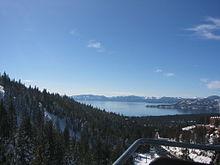
Wetlands are an important part of the Reno/Tahoe area. They act as a natural filter for the solids that come out of the water treatment plant. Plant roots absorb nutrients from the water and naturally filter it. Wetlands are home for over 75% of the species in the Great Basin. However, the area's wetlands are at risk of being destroyed due to development around the city. While developers build on top of the wetlands they fill them with dirt destroying the habitat they create for the plants and animals. Washoe county has devised a plan that will help protect these ecosystems: Mitigation. In the future, when developers try to build over a wetland, they will be responsible for creating another wetland near Washoe Lake.
The Truckee River serves as Reno's primary source of drinking water. It supplies Reno with 80 million U.S. gallons (300 Ml) of water a day during the summer, and 40 million U.S. gallons (150 Ml) of water per day in the winter. Before the water goes to the homes around the Reno area, it must go to one of two water treatment plants, Chalk Bluff or Glendale Water Treatment Plant. As an attempt to save water, golf courses in Reno, like Arrow Creek Golf Course, have been using treated effluent water instead of treated water from one of Reno's water plants.
The Reno-Sparks wastewater treatment plant discharges tertiary treated effluent to the Truckee River. In the 1990s this capacity was increased from 20 to 30 million U.S. gallons (70 to 110 million liters) per day. While treated, the effluent contains suspended solids, nitrogen, and phosphorus, aggravating water quality concerns of the river and its receiving waters of Pyramid Lake. Local agencies working with the U.S. Environmental Protection Agency have developed a number of watershed management strategies to accommodate this expanded effluent discharge; to accomplish this successful outcome, the DSSAM Model was developed and calibrated for the Truckee River in order to analyze the most cost effective available management strategy set. The resulting management strategies included a package of measures such as land use controls in the Lake Tahoe basin, urban runoff controls in Reno and Sparks and best management practices for wastewater discharge.
The Reno area is frequently subject to wildfires, causing property damage and sometimes loss of life. In August 1960, the Donner Ridge fire resulted in a loss of electricity to the city for four days. In November 2011, arcing from powerlines caused a fire in Caughlin in south-west Reno that destroyed 26 homes and killed one older man, and only two months later in January 2012 another fire in Washoe Drive sparked by fireplace ashes destroyed 29 homes and killed one older woman. Around 10,000 residents were evacuated and a state of emergency was declared. The fires came at the end of Reno's longest recorded dry spell.
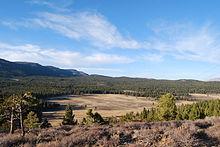
Reno is situated just east of the Sierra Nevada on the western edge of the Great Basin at an elevation of about 4,400 feet (1,300 m) above sea level. Numerous faults exist throughout the region. Most of these are normal (vertical motion) faults associated with the uplift of the various mountain ranges, including the Sierra Nevada mountain range.
In February 2008, an earthquake swarm began to occur with some quakes registering between 4 and 4.5 on the Richter magnitude scale. The earthquakes were centered around the Somersett community in Western Reno near the areas of Mogul and Verdi. Many homes in these areas were damaged.
Reno sits in the rain shadow of the Sierra Nevada Mountain Range. Annual rainfall averages 7.48 inches (190 mm). Despite this low amount of rainfall per year, Reno features a steppe climate due to its low evapotranspiration. Annual precipitation has ranged from 1.55 inches (39.4 mm) in 1947 to 13.23 inches (336.0 mm) in 1983. The most precipitation in one month was 5.25 inches (133.4 mm) in December 1955 and the most precipitation in 24 hours was 2.29 inches (58.2 mm) on January 21, 1943. Winter has snowfall which is usually light to moderate but can be heavy some days, averaging 23.8 inches (60 cm) annually. Snowfall varies with the lowest amounts (roughly 19 ae23 inches annually) at the lowest part of the valley at and east of the Reno/Tahoe International airport at 4404 feet, while the foothills of the Carson range to the west ranging from 4700 to 5600 just a few miles west of downtown can receive up to 2 ae3 times as much annual snowfall. The mountains of the Virginia range to the east can receive more summer thunderstorms and precipitation, and around twice as much annual snowfall above 5500 feet. However, Snowfall increases up in the Virginia Range are less dramatic as elevation climbs than the Carson Range to the West because the Virginia Range is well within the Rain Shadow of the Sierra Nevada and Carson range. The most snowfall in one year was 63.8 inches (162 cm) in 1971 and the most snowfall in one month was 29.0 inches (74 cm) in March 1952. Most rainfall occurs in winter and spring. The city has 300 days of sunshine per year. Summer thunderstorms can occur between April and October. The eastern side of town and the mountains east of Reno tend to be prone to thunderstorms more often and these storms may be severe because an afternoon downslope west wind, called a "Washoe Zephyr", can develop in the Sierra Nevada, causing air to be pulled down in the Sierra Nevada and Reno, destroying or preventing thunderstorms but the same wind can push air upwards against the Virginia range and other mountain ranges east of Reno, creating powerful thunderstorms.
Summer highs are in the low to mid 90s °F (32 ae36 °C), but temperatures above 100 °F (38 °C) occur. The July high daytime temperature peaks at an averages 93 °F (33.9 °C); the night low 52 °F (11.1 °C); while January high daytime temperatures average 45 °F (7.2 °C) and low night temperatures average 21 °F ( na6.1 °C). The record high temperature was 108 °F (42 °C) on July 10 and 11, 2002. The record low temperature was na19 °F ( na28 °C) on January 8, 1890. In addition, the region is windy throughout the year; observers such as Mark Twain have commented about the "Washoe Zephyr", northwestern Nevada's distinctive wind.
Reno has a democratic municipal government. The city council is the core of the government, with seven members. Five of these council people represent districts of Reno, and are vetted in the primary by the citizens of each district.
In general, the top two vote earners in each ward make the ballot for the city-wide election.
The other two members are the at-large, who represent the entire city, and the mayor, who is elected by the people of the city. The council has several duties, including setting priorities for the city, promoting communication with the public, planning development, and redevelopment.
There is an elected city attorney who is responsible for civil and criminal cases. The City Attorney represents the city government in court, and prosecutes misdemeanors.
The city's charter calls for a council-manager form of government, meaning that the council appoints only two positions, the city manager, who implements and enforces the policies and programs the council approves, and the city clerk.
The city manager in charge of the budget and workforce for all city programs. The city clerk, who records the proceedings of the council, makes appointments for the council, and makes sure efficient copying and printing services are available.
In 2010, there was a ballot question asking whether the Reno city government and the Washoe County government should explore the idea of becoming one combined governmental body. 54% of voters approved of the ballot measure to make an inquiry into consolidating the governments.
The 2010 census bureau showed that the percentage of adults with a bachelor degree or higher is 28.5% in Reno compared with 21.8 for Nevada. This compares with 55.1% for Seattle and 51.2% for San Francisco.
Public education is provided by the Washoe County School District.
Reno has many charter schools, which include: Academy for Career Education, serving grades 10 ae12, opened 2002. Bailey Charter Elementary School, serving grades K-6, opened 2001. Coral Academy of Science, serving grades K-12, opened 2000. Davidson Academy, serving grades 6 ae12, opened 2006. High Desert Montessori School, serving grades PreK-7, opened 2002. I Can Do Anything Charter School, serving grades 9 ae12, opened 2000. Rainshadow Community Charter High School, serving grades 9 ae12, opened 2003. Sierra Nevada Academy Charter School, serving grades PreK-8, opened 1999. TEAM A (Together Everyone Achieves More Academy), serving grades 9 ae12, opened 2004. Alpine Academy Charter High School, serving grades 9 ae12, opened 2009.
Reno has a few private elementary schools such as Legacy Christian School, Excel Christian School, and Lamplight Christian School as well as private high schools, the largest of which are Bishop Manogue High School and Sage Ridge School (SRS).
Washoe County Library System has locations throughout Reno and its surrounding communities.
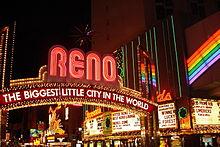
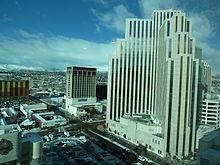

Before the late 1950s, Reno was the gambling capital of the United States, but in the last twenty years Las Vegas' rapid growth, American Airlines' 2000 buyout of Reno Air and the growth of Indian gambling gaming in California have reduced its business. Older casinos were either torn down (Mapes Hotel, Fitzgerald's Nevada Club, Primadonna, Horseshoe Club, Harold's Club, Palace Club) or smaller casinos like the Comstock, Sundowner, Golden Phoenix, Kings Inn, Money Tree, Virginian, and Riverboat were either closed or were converted into condos.
Because of its geographical proximity, Reno has traditionally drawn the majority of its California tourists and gamblers from the San Francisco Bay Area and Sacramento, while Las Vegas has historically served more tourists from Southern California and the Phoenix area.
Several local large hotel casinos have shown significant growth and have moved gaming further away from the Virginia Street core. These larger hotel casinos are the Atlantis, the Peppermill and the Grand Sierra Resort. The Peppermill was chosen as the most outstanding Reno gaming/hotel property by Casino Player and Nevada magazines. In 2005, the Peppermill Hotel Casino began a $300 million dollar Tuscan-themed expansion.
In an effort to bring more tourism to the area, Reno holds several events throughout the year, most of which have been extremely successful. They include Hot August Nights (a classic car convention), Street Vibrations (a motorcycle fan gathering and rally), The Great Reno Balloon Race, the Best in the West Nugget Rib Cook-off (held in Sparks), a Cinco de Mayo celebration, bowling tournaments (held in the National Bowling Stadium), and the Reno Air Races.
Several large commercial developments were constructed during the mid-2000s boom, such as The Summit in 2007 and Legends at Sparks Marina in 2008.
Reno is the location of the corporate headquarters for numerous companies, including Braeburn Capital, Hamilton, Port of Subs, PC-Doctor, and International Game Technology, which manufactures slot machines. Bally Technologies and GameTech have development and manufacturing presence in Reno.
According to Reno's 2011 Comprehensive Annual Financial Report, the top employers in the city are:
As of the census of 2000, there were 180,480 people, 73,904 households, and 41,681 families residing in the city. The population density was 1,008.3 per square mile (2,611.4/km ²). There were 79,453 housing units at an average density of 1,149.6 per square mile (443.9/km ²). The racial makeup of the city was 77.5% White, 2.6% African American, 1.3% Native American, 5.3% Asian, 0.6% Pacific Islander, 9.3% from other races, and 3.6% from two or more races. Hispanic or Latino of any race were 19.2% of the population. Mexican Americans made up 29.0% of the city's population. Non-Hispanic Whites were 62.5% of the population in 2010, down from 88.5% in 1980.
There were 73,904 households out of which 27.6% had children under the age of 18 living with them, 40.5% were married couples living together, 10.6% had a female householder with no husband present, and 43.6% were non-families. 32.6% of all households were made up of individuals and 9.2% had someone living alone who was 65 years of age or older. The average household size was 2.38 and the average family size was 3.06.
In the city the population was spread out with 23.2% under the age of 18, 11.8% from 18 to 24, 31.5% from 25 to 44, 22.2% from 45 to 64, and 11.4% who were 65 years of age or older. The median age was 34 years. For every 100 females there were 104.6 males. For every 100 females age 18 and over, there were 104.0 males.
The median income for a household in the city was $40,530, and the median income for a family was $49,582. Males had a median income of $33,204 versus $26,763 for females. The per capita income for the city was $22,520. About 8.3% of families and 12.6% of the population were below the poverty line, including 16.3% of those under age 18 and 7.1% of those age 65 or over.
The population was 180,480 at the 2000 census; in 2010, its population was estimated at 225,221, making it the third-largest city in the state after Las Vegas and Henderson, and the largest outside of Clark County. Reno lies 26 miles (42 km) north of the Nevada state capital, Carson City, and 22 miles (35 km) northeast of Lake Tahoe in a shrub-steppe. Reno shares its eastern border with the city of Sparks and is the larger of the principal cities of the Reno-Sparks, Nevada Metropolitan Statistical Area (MSA), a metropolitan area that covers Storey and Washoe counties. The MSA had a combined population of 425,417 at the 2010 census. The MSA is combined with the Fernley Micropolitan Statistical Area to form the Reno-Sparks-Fernley Combined Statistical Area, which had a total population of 477,397 at the 2010 census.
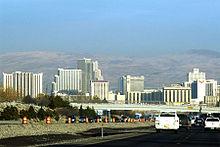
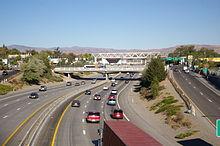
Reno was historically served by the Victory Highway and a branch of the Lincoln Highway. After the formation of U.S. Highways, U.S. Route 40 was historically routed along 4th street through downtown Reno, before being replaced with Interstate 80. The primary north-south highway through Reno is U.S. Route 395/Interstate 580.
Regional Transportation Commission of Washoe County (RTC) has a bus system that provides intracity buses, intercity buses to Carson City, and an on-demand shuttle service for disabled persons. The bus system has its main terminal on 4th Street in downtown Reno and secondary terminals in Sparks and at Meadowood Mall in south Reno.
Numerous shuttle and excursion services are offered connecting the Reno-Tahoe International Airport to various destinations:
Reno was historically a stopover along the First Transcontinental Railroad, the modern Overland Route continues to run through Reno. Reno was historically the southern terminus of the Nevada-California-Oregon Railway (NCO) and the northern terminus of the Virginia and Truckee Railroad. Using the NCO depot and right of way, the Western Pacific Railroad historically provided rail service to Reno. Downtown Reno has two historic train depots, the inactive Nevada-California-Oregon Railroad Depot and the still active Amtrak depot, originally built by the Southern Pacific Railroad.
Amtrak provides daily passenger service to Reno via the California Zephyr and multiple Amtrak Thruway Motorcoaches connecting to trains departing from Sacramento, California.
The city is served by Reno/Tahoe International Airport, with general aviation traffic handled by Reno Stead Airport. Reno/Tahoe International Airport is the second busiest commercial airport in the state of Nevada after McCarran International Airport in Las Vegas. Reno was the hub and headquarters of the defunct airline Reno Air.
Potable water for the City of Reno is provided by the Truckee Meadows Water Authority. The Truckee River is the primary water source, with the purification being done at two plants, Chalk Bluff and Glendale. The Chalk Bluff plant main intakes are west of Reno in Verdi, with the water flowing through a series of flumes and ditches to the plant itself. Alternative intakes are located below the plant along the banks of the Truckee River itself. The Glendale plant is sited alongside the river, and is fed by a rock and concrete rubble diversion dam a short distance upstream.
Sewage treatment for the majority of the Truckee Meadows takes place at the Truckee Meadows Water Reclamation Facility at the eastern edge of the valley. Treated effluent returns to the Truckee River by way of Steamboat Creek.
Electrical power and natural gas are provided by NV Energy, formerly Sierra Pacific. Power comes from multiple sources, including Tracy-Clark Station to the east, and the Steamboat Springs binary cycle power plants at the southern end of town.
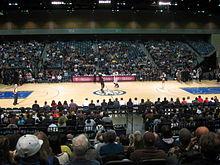
Reno is home to the Reno Aces, the minor league baseball Triple-A affiliate of the Arizona Diamondbacks, and plays in Aces Ballpark, a downtown ballpark opened in 2009. Reno has hosted multiple professional baseball teams in the past, most under the Reno Silver Sox name. The Reno Astros, a former professional, unaffiliated baseball team, played at Moana Stadium until 2009.
In basketball, the Reno Bighorns, a 2008 expansion of the NBA Development League, plays at the Reno Events Center.
Reno is host to both amateur and professional combat sporting events such as mixed-martial arts and boxing. The "Fight of the Century" between Jack Johnson and James J. Jeffries was held in Reno in 1910. Boxer Ray Mancini fought four of his last five fights in Reno against Bobby Chacon, Livingstone Bramble, Hector Camacho, and Greg Haugen.
Reno is expected to be the future home of an ECHL ice hockey team, currently named the Reno Raiders, but construction on a suitable arena has yet to begin as of the 2011 ae2012 season. The franchise has been dormant since 1998, when it was named the Reno Rage, and earlier the Reno Renegades, and played in the now defunct West Coast Hockey League (WCHL).
The Reno-Tahoe Open is northern Nevada aos only PGA TOUR event, held at MontrRªux Golf & Country Club in Reno. As part of the FedEx Cup, the tournament follows 132 PGA TOUR professionals competing for a share of the event aos $3 million purse. The Reno-Tahoe Open Foundation has donated more than $1.8 Million to local charities.
Reno has a college sports scene, with the Nevada Wolf Pack appearing in football bowl games and an Associated Press Top Ten ranking in basketball in 2007.
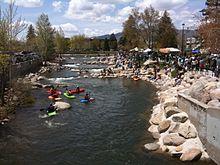
In 2004, the city completed a $1.5 million whitewater park on the Truckee River in downtown Reno which hosts whitewater events throughout the year. The course runs Class 2 and 3 rapids with year-round public access. The 1,400-foot (430 m) north channel features more aggressive rapids, drop pools and "holes" for rodeo kayak-type maneuvers. The milder 1,200 ft (370 m) south channel is set up as a kayak slalom course and a beginner area.
Reno is home to two roller derby teams, the Battle Born Derby Demons and the Reno Roller Girls. The Battle Born Derby Demons compete on flat tracks locally and nationally. They are the only Derby team locally to compete in a national Derby league.
Reno is the home of the National Bowling Stadium, which hosts the United States Bowling Congress (USBC) Open Championships every three years.
The resort region around Lake Tahoe on the California-Nevada borders have formed the Reno-Tahoe Winter Games Coalition to make a bid for the 2022 Winter Olympics. They cited the airport, close mountains, and compact geographic area in which the games could be held. Squaw Valley Ski Resort, which hosted the 1960 Winter Olympics, is considered a major advantage to the bid.
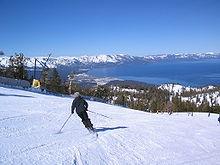
Reno is home to a variety of recreation activities including both seasonal and year-round. In the summer, Reno locals can be found near three major bodies of water: Lake Tahoe, the Truckee River, and Pyramid Lake. The Truckee River originates at Lake Tahoe and flows west to east through the center of downtown Reno before terminating at Pyramid Lake to the north. The river is a major part of Artown, held in the summer at Wingfield Park. Washoe Lake is a popular kite and windsurf location because of its high wind speeds during the summer.
Skiing and snowboarding are among the most popular winter sports and draw in many tourists. There are 18 ski resorts (8 major resorts), including Northstar-at-Tahoe, Sierra-at-Tahoe, Alpine Meadows, Squaw Valley Ski Resort, Sugar Bowl, Diamond Peak, Heavenly Mountain Resort, and Mount Rose Ski Resort located as close as eleven miles (18 km) and as far as ninety-eight miles from the Reno-Tahoe International Airport. Other popular Reno winter activities include snowshoeing, ice skating, and snowmobiling. There are many bike paths to ride in the summer time. International bike competitions are held in Lake Tahoe over the summer time.
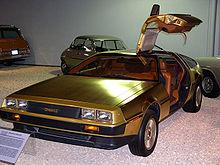
Movies filmed in Reno include:
Music Videos filmed in Reno include:
Reno has six sister cities:
Wanganui, New Zealand was a sister city from 1974 to 2009.
 North America portal
North America portal
Word Count: 5578





